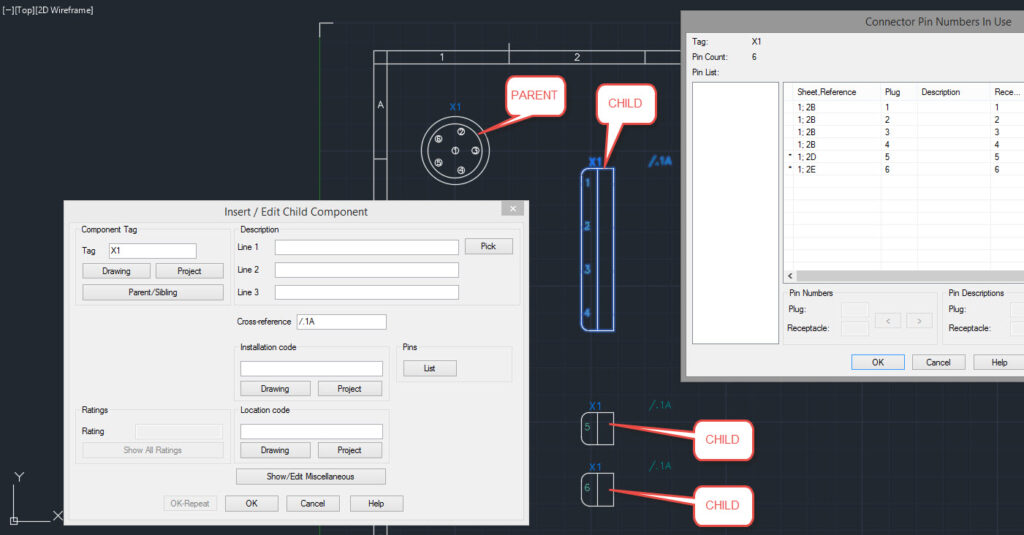Comprehensive Guide: How to Use the Connector Pin List

In the realm of electrical engineering and design, the connector pin list is an invaluable tool. It serves as a comprehensive reference for all the connections within an electrical system, detailing each pin’s function, type, and connectivity. Understanding how to effectively use the connector pin list can significantly streamline the design process, enhance communication between team members, and ensure the accuracy and reliability of electrical systems. This comprehensive guide will walk you through everything you need to know about utilizing the connector pin list effectively.
Table of Contents
- Introduction
- 1.1 What is a Connector Pin List?
- 1.2 Importance of the Connector Pin List
- 1.3 Objectives of this Guide
- Components of a Connector Pin List
- 2.1 Pin Number
- 2.2 Pin Name
- 2.3 Pin Type
- 2.4 Pin Function
- 2.5 Electrical Characteristics
- Creating a Connector Pin List
- 3.1 Gathering Information
- 3.2 Organizing the List
- 3.3 Using Software Tools
- Navigating and Understanding the List
- 4.1 Filtering and Sorting
- 4.2 Understanding Pin Types
- 4.3 Verifying Connectivity
- Collaboration and Documentation
- 5.1 Sharing the Pin List
- 5.2 Incorporating Feedback
- 5.3 Documenting Changes
- Best Practices for Using Connector Pin Lists
- 6.1 Consistency is Key
- 6.2 Regular Updates
- 6.3 Version Control
- Troubleshooting and Verification
- 7.1 Pin Mismatches
- 7.2 Signal Integrity Issues
- 7.3 Verifying Against Schematics
- Integration with Design Tools
- 8.1 CAD Software Integration
- 8.2 PLM and ERP Integration
- 8.3 Test and Measurement Tools
- Case Studies and Real-World Applications
- 9.1 Automotive Industry
- 9.2 Aerospace Applications
- 9.3 Consumer Electronics
- Future Trends and Innovations
- 10.1 Automation and AI
- 10.2 Cloud-Based Collaboration
- 10.3 IoT Integration
1. Introduction
1.1 What is a Connector Pin List?
A connector pin list, often referred to as a pinout or pin assignment document, is a detailed listing of all the pins within a connector, along with their respective functions, types, and electrical characteristics. It provides a comprehensive overview of how different components within an electrical system are interconnected and how signals are routed between them.
1.2 Importance of the Connector Pin List
The connector pin list serves as a vital reference for engineers, designers, and technicians involved in the design, assembly, and maintenance of electrical systems. It ensures consistency and accuracy in wiring diagrams, facilitates troubleshooting and debugging, and enables efficient communication between team members.
1.3 Objectives of this Guide
This guide aims to provide a comprehensive overview of how to effectively use the connector pin list in electrical engineering and design. It covers everything from creating and navigating the pin list to collaboration, documentation, and troubleshooting. By following the guidelines outlined in this guide, users can harness the full potential of the connector pin list to optimize their design processes and ensure the reliability and performance of their electrical systems.
2. Components of a Connector Pin List
2.1 Pin Number
Each pin in the connector is assigned a unique identifier, typically referred to as the pin number. The pin number serves as a reference point for identifying and locating pins within the connector.
2.2 Pin Name
In addition to the pin number, each pin is assigned a descriptive name that indicates its function or purpose within the system. The pin name provides clarity and context, making it easier for users to understand the role of each pin.
2.3 Pin Type
The pin type specifies the electrical characteristics of the pin, such as whether it is an input, output, power, ground, or other signal type. Understanding the pin type is essential for ensuring proper signal routing and connectivity within the system.
2.4 Pin Function
The pin function describes the specific role or task performed by the pin within the system. This could include transmitting data, receiving signals, providing power, or grounding.
2.5 Electrical Characteristics
Finally, the connector pin list may include information about the electrical characteristics of each pin, such as voltage levels, current ratings, signal frequencies, and impedance requirements. These details are critical for ensuring proper signal integrity and compatibility within the system.
3. Creating a Connector Pin List
3.1 Gathering Information
To create a connector pin list, start by gathering information about the connectors used in the system. This includes identifying the types of connectors, the number of pins in each connector, and the specifications provided by the connector manufacturer.
3.2 Organizing the List
Organize the pin list in a structured format, grouping pins by connector type and arranging them in numerical order. Use clear headings and labels to make the list easy to navigate and understand.
3.3 Using Software Tools
Consider using specialized software tools or applications designed for creating and managing connector pin lists. These tools often provide templates, automation features, and customization options to streamline the process and ensure accuracy.
4. Navigating and Understanding the List
4.1 Filtering and Sorting
Use filtering and sorting features to quickly locate specific pins or connectors within the list. This can be especially helpful when working with large or complex pin lists containing numerous connectors and pins.
4.2 Understanding Pin Types
Take the time to familiarize yourself with the different pin types and their respective functions and characteristics. This will help ensure that you correctly interpret the information presented in the pin list and make informed design decisions.
4.3 Verifying Connectivity
Verify the connectivity of pins within the list against the system’s wiring diagrams or schematic drawings. This helps ensure that the pin list accurately reflects the intended connections and that there are no discrepancies or errors.
5. Collaboration and Documentation
5.1 Sharing the Pin List
Share the pin list with other team members, stakeholders, or suppliers involved in the design and assembly process. This promotes transparency and collaboration, allowing everyone to access and reference the pin list as needed.
5.2 Incorporating Feedback
Encourage feedback from team members and stakeholders on the accuracy and completeness of the pin list. Incorporate any suggested revisions or updates to ensure that the pin list remains current and accurate throughout the design process.
5.3 Documenting Changes
Document any changes or revisions made to the pin list, including the date, reason for the change, and the individual responsible for making the change. This helps maintain a clear audit trail and ensures accountability for any modifications to the pin list.
6. Best Practices for Using Connector Pin Lists
6.1 Consistency is Key
Maintain consistency in naming conventions, formatting, and terminology used in the pin list to minimize confusion and errors.
3.5
complete itChatGPT
6.2 Regular Updates
Regularly update the pin list to reflect any changes or additions to the electrical system. This includes updating pin assignments, adding new connectors or pins, and revising existing information based on feedback or design revisions.
6.3 Version Control
Implement version control procedures to track revisions and updates to the pin list effectively. This ensures that team members are always working with the most current version of the pin list and helps prevent confusion or errors resulting from outdated information.
7. Troubleshooting and Verification
7.1 Pin Mismatches
In case of discrepancies or mismatches between the pin list and the actual wiring or schematic diagrams, conduct thorough troubleshooting to identify and resolve the issue promptly. This may involve verifying connector orientations, pin assignments, or signal routing paths to ensure alignment with the pin list.
7.2 Signal Integrity Issues
If encountering signal integrity issues, such as signal degradation or noise interference, refer to the pin list to verify the electrical characteristics and connectivity of the affected pins. Ensure that signal paths adhere to the specified impedance requirements and that proper grounding and shielding measures are implemented as per the pin list.
7.3 Verifying Against Schematics
Cross-reference the pin list with the system’s schematic diagrams or wiring diagrams to confirm consistency and accuracy. Verify that the connections depicted in the schematic drawings align with the information provided in the pin list and that there are no discrepancies or omissions.
8. Integration with Design Tools
8.1 CAD Software Integration
Integrate the connector pin list with CAD (Computer-Aided Design) software tools used for schematic design or PCB (Printed Circuit Board) layout. Many CAD applications offer features for importing, exporting, or linking pin list data, facilitating seamless integration with the design workflow.
8.2 PLM and ERP Integration
Integrate the pin list with PLM (Product Lifecycle Management) or ERP (Enterprise Resource Planning) systems to ensure consistency and traceability across the product development lifecycle. Linking the pin list with these systems enables comprehensive management of design data, revisions, and change control processes.
8.3 Test and Measurement Tools
Utilize test and measurement tools to validate the connectivity and functionality of the electrical system based on the information provided in the pin list. Test equipment such as multimeters, oscilloscopes, and signal generators can be used to verify signal integrity, continuity, and performance according to the pin list specifications.
9. Case Studies and Real-World Applications
9.1 Automotive Industry
In the automotive industry, connector pin lists are extensively used in the design and assembly of vehicle electrical systems. Automotive manufacturers rely on detailed pinout diagrams to ensure accurate wiring harness assembly, proper integration of electronic components, and compliance with industry standards and regulations.
9.2 Aerospace Applications
Aerospace engineers leverage connector pin lists to design complex avionics systems, navigation equipment, and communication networks for aircraft and spacecraft. Pinout documentation plays a critical role in ensuring the reliability, safety, and performance of onboard electronics under demanding environmental conditions.
9.3 Consumer Electronics
Consumer electronics companies utilize connector pin lists to facilitate the design and manufacturing of smartphones, tablets, computers, and other electronic devices. Pinout specifications help engineers optimize PCB layouts, minimize signal interference, and enhance product durability and manufacturability.
10. Future Trends and Innovations
10.1 Automation and AI
Future advancements in automation and AI technology are expected to streamline the creation and management of connector pin lists, offering intelligent tools for pin assignment, signal routing, and documentation generation. AI algorithms may also assist in detecting and resolving pinout errors or inconsistencies automatically.
10.2 Cloud-Based Collaboration
Cloud-based collaboration platforms will continue to play a significant role in enabling real-time sharing, editing, and version control of connector pin lists among distributed design teams. Cloud integration ensures seamless access to up-to-date pinout information from anywhere, at any time, fostering collaboration and innovation.
10.3 IoT Integration
Integration with IoT (Internet of Things) technologies will extend the capabilities of connector pin lists to encompass smart, connected devices and systems. IoT-enabled sensors and actuators will require comprehensive pinout documentation to facilitate interoperability, data exchange, and remote monitoring/control capabilities.
By adhering to the principles and best practices outlined in this guide, engineers, designers, and technicians can effectively leverage the connector pin list as a powerful tool for designing, documenting, and troubleshooting electrical systems. Whether working on automotive, aerospace, consumer electronics, or emerging IoT applications, mastering the use of the connector pin list is essential for ensuring the reliability, performance, and success of electrical designs in the modern era.







